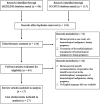Haematological malignancies during pregnancy: a systematic review of necessary services in the Australian context
- PMID: 40042130
- PMCID: PMC11900863
- DOI: 10.1111/imj.16651
Haematological malignancies during pregnancy: a systematic review of necessary services in the Australian context
Abstract
Background: Haematological malignancies diagnosed during pregnancy are rare, with increasing incidence, presenting unique therapeutic, social and ethical challenges for treating teams, patients and their family. There are no national guidelines regarding appropriate referral pathways, resources and services for the management of these patients.
Aims: To conduct a systematic review of the literature to identify the multidisciplinary team members required for optimal care of pregnant patients with haematological malignancies. These data will be used to evaluate the capabilities of Australian health networks to provide coordinated care.
Methods: A systematic review of the literature in MEDLINE and SCOPUS databases was conducted. Eligible studies focused on pregnant Australian patients with haematological malignancies, exploring care models, specialist teams and services utilised. This was then used to generate a map of Australian hospitals that can service this patient demographic.
Results: Essential team members include haematologists, maternal-fetal medicine specialists, anaesthetists, midwives, intensive care specialists, psychologists and social workers. Services utilised include haematology, maternity, intensive care, tertiary imaging, operating theatre, pharmacy and perinatal mental health services. Utilising these data, 25 hospitals can manage these patients.
Conclusions: This study identified the necessary healthcare practitioners, services and hospitals available that can manage this patient cohort. Future research should focus on determining ideal treatment regimens, timing of therapy throughout gestation, establishing a national patient registry and implementing a cancer care plan and frameworks for best practice care. A centralised referral pathway leveraging telehealth will allow expedient, multidisciplinary action and equity in access to all women across Australia.
Keywords: Australia; haematological malignancy; haematology; leukaemia; lymphoma; pregnancy.
© 2025 The Author(s). Internal Medicine Journal published by John Wiley & Sons Australia, Ltd on behalf of Royal Australasian College of Physicians.
Figures




References
-
- Shah MR, Brandt JS, David KA, Evens AM. Lymphoma occurring during pregnancy: current diagnostic and therapeutic approaches. Curr Oncol Rep 2020; 22: 113. - PubMed
-
- Brenner B, Avivi I, Lishner M. Haematological cancers in pregnancy. Lancet 2012; 379: 580–587. - PubMed
-
- Van Calsteren K, Heyns L, De Smet F, Van Eycken L, Gziri MM, Van Gemert W et al. Cancer during pregnancy: an analysis of 215 patients emphasizing the obstetrical and the neonatal outcomes. J Clin Oncol 2009; 28: 683–689. - PubMed
-
- Cohen JB, Blum KA. Evaluation and management of lymphoma and leukemia in pregnancy. Clin Obstet Gynecol 2011; 54: 556–566. - PubMed
Publication types
MeSH terms
LinkOut - more resources
Full Text Sources
Medical

